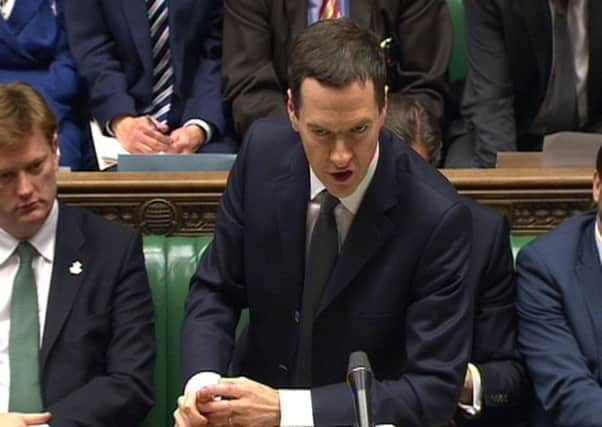Tom Richmond: Deficit and the shadow of Brown loom over Osborne


In the week when the former Labour Chancellor and Prime Minister announced his retirement from Parliament, Osborne’s setpiece speech showed the extent to which the country’s governance has changed since Brown entered 11 Downing Street in 1997.
The Treasury is now Britain’s economic and political power base – a fact underlined by the carefully choreographed drip-feeding of recycled announcements on new roads, flood defences and high street shops to create an impression that this is a government still full of verve and vigour.
Advertisement
Hide AdAdvertisement
Hide AdLike Brown in his pomp, it did not seem to concern Osborne that the upgrading of the A1 from Leeming to Barton in North Yorkshire had been announced as long ago as 2012 or that the £2.3bn allocated to new flood defences was not new money – this is what happens when Chancellors are also full-time election strategists.
Like Brown, Osborne’s preferred modus operandi is to skip through the selective use of statistics – and his haste during key passages appeared to mask the fact that borrowing is being increased to £91bn this year because the record fall in unemployment has not translated into better tax receipts for the Treasury.
And, just as Brown failed to foresee the global financial crash, Osborne appeared to be in denial about the scale of Britain’s indebtedness as he appealed for more time to build “the secure economy that works for everyone”.
In election parlance, he is effectively appealing for “four more years” – the refrain that characterises every re-election campaign undertaken by an American president.
Advertisement
Hide AdAdvertisement
Hide AdThe reality is that this Autumn Statement constitutes four more years of austerity if Britain is to stand any chance of recording a budget surplus in 2018-19 – the Government’s new target.
However there is, of course, one critical difference between the past and present Chancellor of the Exchequer. While Gordon Brown was an old-fashioned “tax and spend” operator, George Osborne is committed to lowering taxes in order to stimulate the economy through an agenda of aspiration and wealth-creation that recognises the economic potential of regions like Yorkshire that were allowed to stagnate under Labour’s welfare-dependency culture.
To his credit, Osborne is the first politician since Michael Heseltine in the early 1980s to realise that the North can become a net contributor to the public finances if the region has the right transport and business infrastructure in place. He is also the first Chancellor who has decided to recognise the potential of stamp duty reform. Like the £2bn NHS boost announced at the weekend, the political merits of the policy are compelling – it represents a boost both to the property market and to first-time buyers. More cynically, it undermines Labour’s case for a “mansion tax” – only homes that cost just over £937,000 will see their stamp duty bill go up.
But then there is the economics and whether such a measure is affordable – and sustainable – when the Chancellor is preparing the country to brace itself for post-election public spending cuts.
Advertisement
Hide AdAdvertisement
Hide AdThat is the problem for the country and again the parallels between the Brown and Osborne leadership styles are striking. The former built his “Iron Chancellor” reputation in Tony Blair’s first term when he adhered to the tight spending plans inherited from Ken Clarke. It was only when these expired that Labour became less disciplined with the public finances – which led to the biggest budget deficit in British history.
As for Osborne, he was resolute in his determination to rein in public spending until the beginning of last year, when he started to offer inducements as the Tories began haemorrhaging electoral support.
The consequence? Osborne has succeeded in creating the impression that the good times have returned. But while it would be churlish not to acknowledge the fact that the UK economy is outperforming the rest of Europe, the growth forecasts are still very modest.
From George Osborne’s point of view, the test of this Autumn Statement is whether it is sufficient to see the Tories win next year’s election. Time will tell.
Advertisement
Hide AdAdvertisement
Hide AdBut I was also intrigued, as Mr Brown prepares to take his leave of Parliament, to read the response to his last Autumn Statement, in 2006.
Three quotations stood out. “The Chancellor talked about sound public finances, but he downgraded his borrowing forecast again.” “The Chancellor’s greatest mistake is that he has spent without reform.” “Does he remember saying when he was shadow Chancellor that he wanted to be remembered as a wise spender, not a big spender?”
Who proferred these words of wisdom? None other than George Osborne when he was shadowing Labour’s last “big beast”. They are criticisms that, in time, could also apply to the current incumbent of the Treasury unless he learns from Brown’s greatest mistake and recognises – sooner rather than later – that Britain is still spending beyond its means.